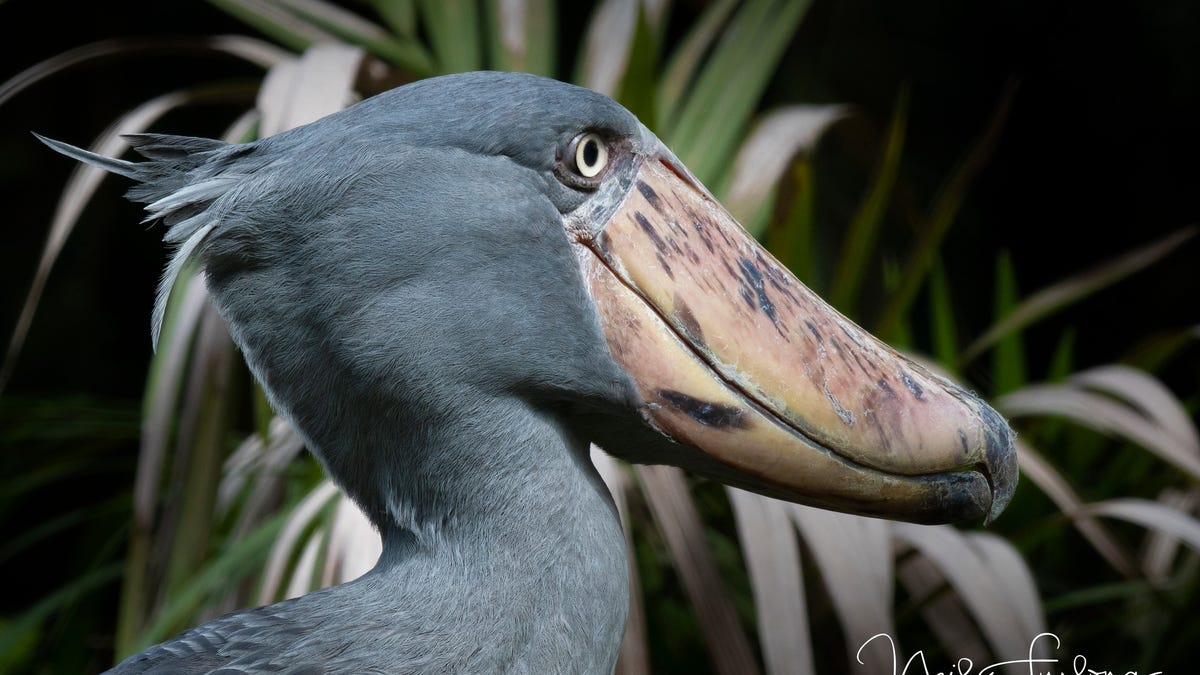Shoebill birds can reach a height of five feet, but the prehistoric-looking creatures generally aren’t taller than people. A viral video’s closeup angle accentuates their impressive size.

Wildlife rescue team saves a baby bald eagle
A wildlife rescue crew saved a baby bald eagle accidentally kicked out of its nest on Catalina Island. They recovered the eaglet from a cliff’s edge.
If you’ve seen the viral video of the large shoebill bird landing on a boat in Africa’s Mabamba Swamp, you might be asking yourself if such a prehistoric-looking, seemingly giant bird could be real.
The simple answer is yes.
Shoebills indeed have very large bills, as their name implies. If you’ve seen a shoebill at a zoo or if you’re among those fortunate enough to have seen one while sightseeing in Africa, you might have found its bill unforgettable.
A shoebill’s most prominent feature is one of the longest bills of any bird species living on Earth, even though they’re not as large as the video makes them appear. If you haven’t seen the video, you can check it out here. The Instagram account that shared the shoebill video, Mabamba Trips, is affiliated with a wildlife trip operator in Uganda.
Shoebills are among a group of birds often compared to dinosaurs for their distinctive appearances. For example, wood storks, a protected bird that has been making a comeback in the Southeast, are sometimes compared to pterodactyls because of their oddly shaped beaks and black heads.
Canadian paleontologist François Therrien chuckled when asked about the comparison to dinosaurs. He once picked up a rock during a dinosaur dig in Alberta, Canada and found the first evidence of feathered dinosaurs in the western hemisphere.
“Birds are just a very specialized type of small meat-eating dinosaurs that learned to fly and were lucky enough to survive the big mass extinction at the end of the Cretaceous 66 million years ago,” said Therrien, curator of dinosaur palaeoecology at the Royal Tyrrell Museum of Palaeontology in Alberta. Birds are the actual lineage of the dinosaurs that survived, so it shouldn’t be surprising that some of them actually do resemble dinosaurs.
Therrien pointed out the angle of the video, with a closeup of the bird, and people standing behind it has the effect of making the bird seem much larger than it is. Shoebills are not generally taller than people.
How big is a shoebill really?
- Shoebills actually can reach a height of five feet, making them taller than young children and taller than some adults, according to BirdLife International.
- The bill’s sharp edges and hook at the tip allows it to grab, grip and kill live prey.
- Although they are sometimes referred to as a stork, they are more closely related to pelicans, according to BirdLife.
- They’re found in freshwater swamps in Africa, from South Sudan to Zambia.
- They can live up to 35 years.
Which birds have the longest beaks or bills?
According to Guinness World Records, the longest beak or bill of any living bird on Earth is that of an Australian pelican, which can measure in at almost 20 inches.
The next three species with the longest bills are also pelicans, including the great white pelican (18.5 inches), the dalmatian pelican (17.7 inches) and the American white pelican (15 inches), according to the website Planetofbirds.com.
Shoebills, hornbills and other similar bird species really do look like dinosaurs, not just because they’re big, but because their heads are so different, Therrien said. The ornamentation found on the beaks and tops of heads of hornbills are a structure similar to the casque on the cassowary, a bird species found in New Guinea and Australia.
These birds “often remind us of dinosaurs because, they’re living on the ground and they develop lots of funky things on their beaks and heads,” Therrien said.
Some of the meat-eating dinosaurs, especially from Mongolia and parts of North America, had a similar “bony helmet,” he said. Scientists know what they look like because the crests are made of bones and not soft tissue that decomposes over time. One North American example is the Anzu, an animal that lived at the very end of the age of the dinosaurs. Its bones have been found in the Dakotas, Montana and in Alberta, Canada.
Why is the shoebill considered ‘vulnerable?’
Africa’s population of shoebills were last evaluated by the International Union for Conservation of Nature in 2018. That assessment concluded the birds were vulnerable, with a declining population estimated then at around 3,000 – 3,500 adult birds. It’s considered at risk of extinction because it has only a single small population, across an area undergoing hunting, nesting disturbances and habitat decline, according to the IUCN’s assessment.
Where is Mabamba Bay?
Mabamba Bay is found in Uganda, on the northwestern shore of Lake Victoria, Africa’s largest lake.
Its almost 6,000 acres of surrounding swamp and wetlands are considered of international importance. The area is home to more than 300 bird species, including the shoebill, a highly prized target for birdwatchers from all over the world.
Where can you see a shoebill?
If you’re not headed out on a safari in Africa anytime soon, you can see shoebills at several zoos in the United States, including at ZooTampa at Lowry Park and the Houston Zoo.
Dinah Voyles Pulver covers climate change, wildlife and the environment for USA TODAY. Reach her at dpulver@usatoday.com or @dinahvp on Bluesky or X or dinahvp.77 on Signal.
